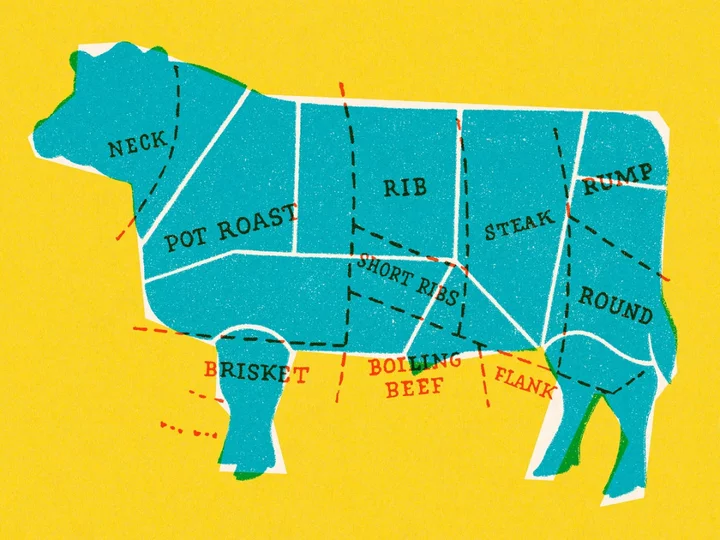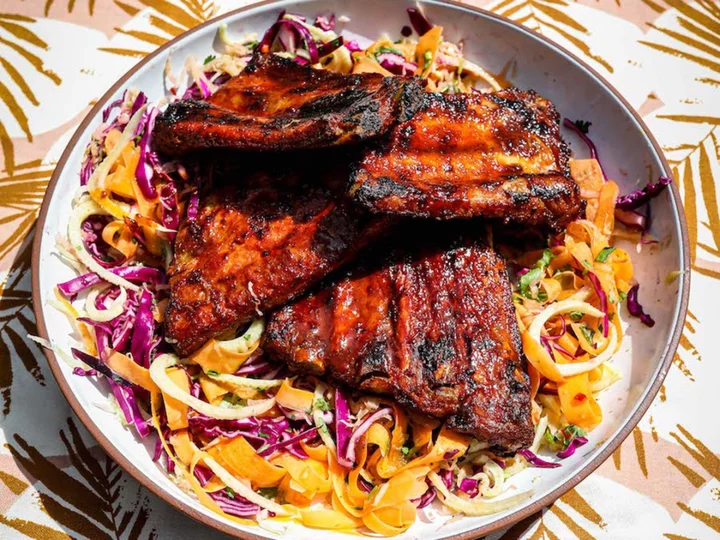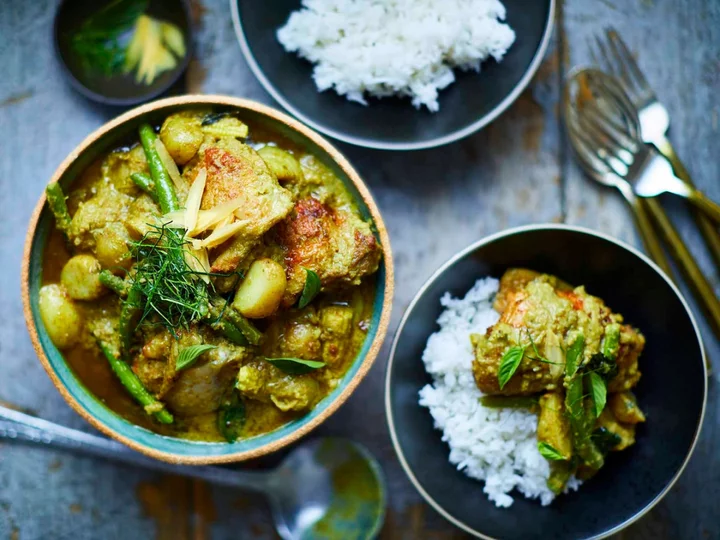
Attention, Shoppers: Wawa Is Now Serving Pizza
The mythical Philly-based convenience store chain is now offering freshly-prepared pizza. But will anyone bite?
2023-08-01 03:17

Blood, guts and cheap cuts: We need an alternative to eating animals – and ‘ethical meat’ isn’t the answer
Amber Husain was cooking dinner for a friend when she suddenly realised the meat she was preparing was a corpse. She looked at the chicken in front of her and was overcome with a visceral sense of disgust. Instead of food, she saw “a carcass – plucked, beheaded, and fleshy”. Husain was 26 when she had this epiphany, and it served as a wake-up call not just for her stomach but her mind, too – as her personal tastes shifted away from meat products, her political outlook on the meat industry and food production more broadly also altered and expanded. Five years later, that moment of revulsion forms the opening of her new book, Meat Love, in which she scrutinises the idea of “ethical” meat consumption, and dares to ask how the contemporary middle classes have come to criticise “the worst violence against animals” while still happily feeding on their flesh. Why, for example, has well-heeled, middle-class London gone nuts for slurping bone marrow from the shin bones of baby cows? Why is offal on so many trendy menus? How has contemporary culture at large come to accept that factory farms are monstrous, but that if animals are cared for, cherished and loved while alive, we should feel better about killing them for our carnivorous pleasures? “For ages, I was one of those carnivores who felt mildly bad about eating meat but just turned that into this inane, self-consciously sadistic part of the pleasure of it all,” Husein tells me. “The more my diet started to revolve around stuff that wasn’t meat, the weirder meat started to feel. Interestingly, once my stomach had been radicalised, I found I had a much greater intellectual openness to thinking about the politics of meat.” Having freed herself from the conflict of eating meat but also feeling bad about it, she found she was able to go beyond those questions of morality – which she suggests can be “stifling” – and think politically. “Now that I have no desire to eat animals, there’s nothing to stop me reckoning with what it means that the meat industry [consists of] an underclass of both humans and animals who are exploited and – in the animals’ case – killed for pleasure and profit.” This is the essential crux of Husain’s argument, and it’s something often lacking in discussions around the “ethics” of meat consumption. For Husain, the question is not, “how can humans eat meat responsibly?” but “how are certain lives devalued to an extent that their suffering can be written off, in order to ‘make a killing’?” What she’s saying, in other words, is that whether the meat on the table has come from a factory farm or an organic farm, or whether you’re tucking in at Burger King or the River Cafe, the path to the plate is still paved with violence. And, while current cultural trends may claim it is better to love and respect an animal before killing and consuming it, perhaps what this cultivates is the ability to embrace exploitation “in a spirit of virtuous indulgence”. What does it really mean, for all living beings, if love is imagined as compatible with killing? “To slide your buttery hand between the flesh and skin of a thing that, if only for a moment, you have re-learnt to perceive as a corpse, is to give an invigorating massage to your sense of political possibility,” Husain writes in Meat Love. By the slim book’s end, her invigorated “sense of political possibility” has led to “a ravenous hunger – a desire for a different culture, a different society”; a new world “in which no one, neither animal, immigrant, worker, woman, or peasant, was considered a thing to be owned, controlled, killed, or left to die”. For many, the leap from a chicken breast on a plate to the exploitation of oppressed people around the globe might seem like a vast one. Yet, it certainly seems clear that there has been a marked shift in the way meat is conceived and consumed – among the middle classes, at least. Since the turn of the millennium, foodie figures like Hugh Fearnley-Whittingstall have been promoting “seasonal, ethically produced food” as part of a broader commitment to caring for the environment. At the same time, a distinctly carnivorous spirit has taken hold – one that professes to be an “honest”, “grounded” and “down to earth” ethos. “Good food, good eating, is all about blood and organs, cruelty and decay,” Anthony Bourdain wrote at the start of the 1999 New Yorker article that would, eventually, catapult him into global foodie fame. I find it easy to laugh at Hugh Fearnley-Whittingstall and people like that, but I’m not totally convinced that they’re really the bad guys Lewis Bassett Then there’s Fergus Henderson and St John – the illustrious London restaurant, born in 1994 on the premises of a former bacon smokehouse, which popularised “nose to tail” dining. This offal-centric “no waste” approach is neatly summed up in Henderson’s oft-quoted phrase: “If you’re going to kill the animal, it seems only polite to use the whole thing.” Traditionally “cheap cuts” are “elevated” from a source of sustenance for the working classes, to a source of virtue for the urban bourgeois. According to its own cookbook, St John dishes combine “high sophistication with peasant roughness” – that winning aesthetic formula that also sees middle-class urbanites flocking to farmers’ markets and chugging natural wine. In a sharp and searing piece for food and culture newsletter Vittles, writer Sheena Patel dubs this “Rich Person Peasantcore”, asking: “Why are these influencers pretending that they themselves till the land and eat like 17th-century French peasants when in fact their chopping boards cost more than most people’s rent?” In the face of swathes of small plates adorned with offal, and slices of ham served for upwards of £20, it seems like a pertinent question not just for influencers, but also for today’s trendiest restaurateurs and diners. Lewis Bassett is a chef and the host of The Full English podcast, which, over its two seasons, has dived into everything from the birth of “modern European” cuisine to high food prices, factory farms, and why Britain is in love with Greggs. “It’s interesting the way we create these fantastical worlds for us to eat within,” he says. “It is clearly a fantasy to imagine that you can have the rural experience of a peasant in France or Italy, in modern-day Britain.” Yet, he also says that this trend is far from new. The current “rustic” style – typified by “nose to tail eating” – is, he suggests, “intimately tied with what you could call a culinary and broader cultural movement that appears in the wake of countercultural movements in the Sixties, and eventually finds its way into food, especially as some of those countercultural people get a bit older and a bit more affluence”. Essentially, “it’s the same thing that manifested in places like Habitat,” he says, of the homewares and furnishings brand founded in 1964 by Terence Conran. Both design and dining were transformed, offering experiences to the middle classes that were both refined and casual at the same time. Alongside that cultural shift, and “that fashion for pared-down forms of eating out”, Bassett notes the arrival of a broader awareness of environmental and animal welfare concerns. “It’s obviously easy to ridicule these middle-class forms of culture,” he says, “but these concerns are ones I certainly share and I think should be considerations for everyone. I find it easy to laugh at Hugh Fearnley-Whittingstall and people like that, but I’m not totally convinced that they’re really the bad guys.” So is there a danger that legitimate backlash to the “thrifty rural”, “nose to tail” trend – and bourgeois “peasantcore” more broadly – could spill over into an attack on all food industry attempts at sustainability? “I think people don’t want stuffy fine dining experiences,” Bassett says, “but at the same time, having the kind of pared-down, rustic, ‘peasant food’ – like, having ham served to you at St John costs you 20 quid – maybe people are slightly sick of that.” He quickly adds, though, that he is “not saying it can come any cheaper than 20 quid, because when you spend a lot of time and effort rearing animals properly, and paying chefs properly, and paying rents in your restaurants, that racks up”. It seems there is a tension, then, between practical and immediate ethical matters – such as paying food industry staff liveable wages or reducing food waste – and broader questions about what kind of society we wish to live in or create. Is the question of “ethical” meat consumption, as Husain suggested, “beyond morality” – a question of politics only? Or is it still, at heart, a moral dilemma, based on people’s personal sense of “right” and “wrong”? Summing up Husain’s attitude towards animals in Meat Love, Bassett suggests “she’s saying that, if you love them so much, why are you killing them? I suppose where Amber Husain and I would slightly disagree is that I’m not convinced that killing an animal is inherently wrong.” Away from the carnal appreciation and “peasantcore” of contemporary restaurant culture, meat-eating often seems to be conceived as either a “guilty pleasure” or a “grim necessity”. In all these cases, however, there appears to be an overriding sense that there is “no alternative” to a meat-eating status quo. The late cultural critic Mark Fisher famously used similar terms to define “capitalist realism”, meaning that capitalism is the only viable economic system, and thus there can be no imaginable alternative. Is it possible we’re also stuck in a kind of “carnivorous realism”? If so, it might be because the two are so interlinked. As Husain puts it, “meat is the inevitable outcome of an economic system that relies on cheap labour and cheap life. But that doesn’t mean meat is a necessity, it means a new economic order is a necessity.” Perhaps taking the leap from a vegetarian diet to full-scale social and economic revolution still seems unthinkable to many. But, in nasty, brutish and austere times, it has also perhaps never been more necessary to seriously consider who can eat, and who is made meat. “I think we need an avalanche of political will from within the food justice, land justice, climate justice and labour movements to radically transform society,” Husain says. With that as the goal, she believes it isn’t helpful “for us to be clinging to the idea of meat as a pleasure”: “If we can’t imagine something other than animal flesh to eat for dinner we might struggle to imagine an entirely different society.” ‘Meat Love: An Ideology of the Flesh’ by Amber Husain is out now Read More Between Brexit and Covid, London’s food scene has become a dog’s dinner – can it be saved? It’s time for booze bottles to have health warning labels Should I give up Diet Coke? With aspartame under suspicion, an addict speaks Food portion sizes on packaging are ‘unrealistic and confusing’, says Which? In Horto: Hearty, outdoorsy fare in a secret London Bridge garden Zero-fuss cooking: BBQ pork ribs and zingy Asian slaw
2023-07-30 13:52

A Brief History of SPAM
From Monty Python to Minnesota's SPAM Museum, this little packaged luncheon meat has a big cultural footprint.
2023-07-28 03:16

Concerns mount over potential for food crisis amid Russian moves to cripple Ukrainian grain exports
The US and its allies are grappling with how to avert a global food crisis following Moscow's withdrawal from the Black Sea grain deal and its subsequent attacks on Ukraine's ports and storage facilities.
2023-07-27 07:54

Gasoline prices are spiking. That's a problem for Powell and the Fed
Prices at the gas pump are suddenly surging, causing headaches for consumers and central bankers alike.
2023-07-26 23:18

Simple, versatile, delicious: Blackberry and peach crumble
This recipe is so simple and versatile – I use it to top fruit throughout the seasons,” says chef Emily Scott. “It is lighter than a traditional oat crumble topping, and delicious served with custard or crème fraîche.” Blackberry and peach crisp Serves: 4 Ingredients: For the Amaretti crumble topping: 160g (5½oz) amaretti biscuits 80g (3oz/scant 1 cup) flaked (slivered) almonds 75g (2½oz) unsalted butter, at room temperature 50g (2oz/scant ½ cup) plain (all-purpose) flour 50g (2oz/scant ¼ cup) caster (superfine) sugar For the bramble and peach filling: 350g (12oz) blackberries 6 peaches, skinned and stoned (pitted), sliced (if using frozen peaches, thaw and drain first) 100g (3½oz/scant ½ cup) caster (superfine) sugar 3 tbsp cornflour (corn starch) slaked with 2 tbsp water Zest and juice of ½ lemon Method: 1. Preheat the oven to 200C (180C fan/400F/gas 6). For the crumble topping, blitz the amaretti biscuits with the flaked almonds in a food processor to a rubble. 2. In a mixing bowl, rub the butter and flour together to resemble breadcrumbs, then add the sugar along with the almond rubble and mix together. 3. Spread the mixture out over a baking sheet and bake in the oven for 10-15 minutes until golden. Allow to cool. 4. For the filling, place the blackberries, peaches, sugar, cornflour mixture, lemon zest and juice in a heavy-based saucepan and slowly bring to a simmer, stirring all the time to allow the sugar to dissolve. Cook until the fruit is tender. 5. Transfer to an oven-to-table baking dish and sprinkle over the amaretti crumble topping. Finish off in the oven for 5–6 minutes. Don’t forget the cream. ‘Time & Tide’ by Emily Scott (Hardie Grant, £28).
2023-07-26 13:47

Recall Alert: These Trader Joe’s Cookies May Contain Rocks
Here’s how to know whether to toss your Trader Joe’s cookies.
2023-07-26 00:16

Zero-fuss cooking: BBQ pork ribs and zingy Asian slaw
Sweet and smokey, melt off the bone BBQ pork ribs and a zingy, Asian-style slaw are this week’s match made in heaven. Ideal for family get togethers and al fresco dining, this showstopper summer dish requires zero-fuss cooking. Serve with cold beers and pitta breads to mop up the goodness. BBQ pork ribs and slaw Serves: 4 Ingredients: 800g BBQ pork ribs 1 tbsp hoisin sauce (optional) For the slaw: 2 carrots, peeled into ribbons ¼ red cabbage, shredded ½ fennel bulb, finely sliced ½ red chilli, deseeded and finely diced 1 tbsp root ginger, grated 2 tbsp sauerkraut 2 tbsp hot lemon sauce 2 tbsp chopped coriander Method: To cook the pork ribs, wrap them in tin foil and bake them in the oven at 150C for 1-1.5 hours, or if you have a BBQ, use that! Remove them from the tin foil and increase the temperature of your grill to 200C. Grill for 15-20 mins, basting regularly with the remaining BBQ marinade (and hoisin sauce, if you’re using it). To prepare the slaw, peel your carrots into ribbons and toss them in a large bowl with the shredded red cabbage, finely sliced fennel, and sauerkraut. Add in the grated root ginger, chopped red chilli and coriander. Instead of mayonnaise, try adding hot lemon sauce to your slaw for a zingy, spiced version. Mix well and season to taste, then serve alongside your BBQ ribs. Read More Five dinner ideas from around the world to try this week Hi Barbie! Nine cocktails inspired by the doll’s most iconic outfits The National Portrait Gallery’s new restaurant is fabulous upgrade Three barbecue recipes to try that aren’t burgers The dish that defines me: Alex Outhwaite’s Vietnamese bun cha 3 TikTok-approved recipes for picnic season
2023-07-25 13:53

Restaurant introduces ‘minimum spend’ that will see solo diners pay double to eat alone
A restaurant in London has sparked criticism over its decision to introduce a minimum spend next month that will see solo diners charged double for their meals. In August, Alex Dilling at Hotel Café Royal, which boasts two Michelin stars, will increase the prices of its tasting menus. Currently, a five-course tasting menu costs £125 per person, while it’s £175 for seven courses. However, from 17 August, the restaurant will increase its prices by 11 per cent, bringing five courses to £165 and seven courses to £195. This is due to an increase in supplier costs and rising staff shortages in London, due to Brexit, that has put pressure on the business. For those dining alone, though, the new minimum spend means solo visitors could be charged a minimum of £330 to visit the restaurant due to the volume of requests they receive. However, the restaurant confirmed that they keep one to two tables for solo diners for every service without the minimum spend. So solo diners who book within 24 to 48 hours of their required booking time could be able to swerve the minimum spend depending on whether those tables are available at the time. Nonetheless, the initiative sparked outrage on Twitter, with commenters quick to point out the joys of dining alone, and how solo diners are often stigmatised. “F*** the Hotel Café Royal then… Solo dining is one of life’s great pleasures,” tweeted one person. “Oh great news. Yet another penalty for being single,” another added. Hugh Smithson-Write, who works in restaurant PR, tweeted: “A classic example of making the customer the problem, rather than finding a solution. “If you get ‘many solo diner requests’ how about you reconfigure your dining room to accommodate that and maximise the revenue? This is the very opposite of hospitality!” Victoria Sheppard, chief executive at Alex Dilling at Hotel Café Royal, told The Independent: “Since achieving our two Michelin stars the demand for solo dining has increased dramatically and whilst we make every effort to accommodate solo diners, we also have to be considerate to the running costs of our business. “That said, we are increasing our opening hours from 17 August and will be able to accommodate more solo diners (without any discretionary minimum spend). 95 per cent of our solo diners requesting tables since we implemented a discretionary minimum spend when we are at capacity for solo diners have been more that happy to proceed with their booking, enjoying wine pairings or champagne of wine alongside their meal. “Nightclubs in our local vicinity have minimum spends for tables or hotels you pay the same price whether one guest or two which is never under dispute.” Read More Michelin star chef Marcus Wareing gives controversial answer to the best pizza in London Tom Kerridge addresses backlash to his £35 fish and chips at Harrods: ‘They shout at me’ Chef defends viral chicken recipe after TikTok backlash: ‘PSA to the seasoning police’ Restaurant with ‘tips are a privilege’ policy sparks intense backlash on social media Cher is launching a gelato brand called ‘Cherlato’ Popeyes widely mocked for attempt to join ‘girl dinner’ trend
2023-07-24 16:27

McDonald's to investigate Irish rape victim taunts
McDonald's UK and Ireland chief executive says he commends Ciara Mangan's bravery in speaking out.
2023-07-23 01:58

Three barbecue recipes to try that aren’t burgers
We all love a good barbecue but sometimes we want something a little more than overcooked burgers and soggy salads. There’s no reason you can’t be adventurous when cooking al fresco, says Farang chef Sebby Holmes. When cooking chicken over a fierce heat, for example, it’s always best to marinate or brine it first. That’s what makes the chicken green curry below so packed full of goodness by the time it hits the barbecue. The same goes for the grilled tiger prawns and citrus som tam salad. A widely eaten salad in Asia, the som tam’s clementine adds a natural sweetness to the juices of the grilled prawns, making this a stand out dish. When cooked over an open fire, aubergine has an amazing ability to transform into a smoky, soft bombshell of flavour. The smoky aubergine, pickled cucumber and sesame salad with runny duck eggs is the perfect accompaniment to a barbecue, and also delicious served with steamed rice as a main. Barbecue chicken green curry When cooking chicken over a fierce heat such as a barbecue, it’s always best to marinate or brine it first. Now, you can honestly spend a lifetime researching the brining process and some people do, however we don’t have time for that! Suffice to say that by leaving raw meat in contact with salt and/or sugar and moisture before cooking, you allow it to take on flavour. This recipe uses the green curry paste to marinate the chicken, meaning it’s packed full of goodness by the time it hits the barbecue. Serves: 2 Ingredients: 20g coconut oil (vegetable oil can also be used instead) 100g green curry Payst 3g kaffir lime leaves, torn a little to release their flavour 10ml fish sauce (if using Payst no seasoning is necessary as it is pre-seasoned) 10-15g palm sugar (if using Payst no seasoning is necessary as it is pre-seasoned) 200ml chicken stock 1 tin coconut cream 4 free-range chicken thighs on the bone (400-600g total weight) 100g new potatoes, sliced in half 80g baby sweetcorn, sliced at an angle 80g green beans, sliced in half lengthways 10g krachai wild ginger, peeled and julienned (if you can’t find this, use the larger, more common ginger) 10g Thai sweet basil A piece of wood for smoking on the BBQ (my favourite is hickory) Method: Heat the coconut oil in a large saucepan over a high heat, then add the green curry paste and kaffir lime leaves and stir regularly until the paste begins to split like scrambled eggs – this will take a few minutes. You will notice that the smell of the ingredients changes from raw to fragrant. At this point, add 10ml fish sauce and allow it to cook into the paste for 1 minute (don’t add too much as it is strong and you can always add, but never take away). Next, add the sugar and cook for a minute or so until melted and beginning to caramelise – this is noticeable as the paste begins to darken. Now it’s time to loosen the curry with liquids. Add half the chicken stock and 100ml of the coconut cream to the pan, then remove from the heat and allow to cool. When cool, use a little of the curry to marinate the chicken thighs; use enough to coat them, then refrigerate the chicken to allow the flavours to infuse for a minimum of 2 hours, but ideally overnight. Light the barbecue and wait for the coals to glow red. Place the piece of wood onto the coals and allow to set alight and begin to smoke. At this point, add the chicken thighs skin-side up and cook for 3-4 minutes on one side, lowering the BBQ lid so that the meat is engulfed by the smoke. Turn the chicken pieces over and repeat the process until the skin is crispy and golden brown and the chicken is piping hot. Next, return the remaining green curry to the pan and bring back to a simmer. Add any excess from the marinated chicken, then add the remaining stock. Add the potatoes and cook for about 8 minutes until they begin to soften. Add the sweetcorn and green beans and cook for a further 5 minutes until all the vegetables are softened but still retain a little bite. Add the hot chicken thighs, the remaining coconut cream and the krachai and basil. Check you are happy with the seasoning, add a little more fish sauce, sugar or coconut milk if needed and serve immediately. This dish is best served with steamed jasmine rice. Grilled tiger prawns and citrus som tam salad Som tam has fast become one of the most widely eaten and popular salads to come out of Asia. It originates from Lao, but now has many well-known variations from all over. This version is one I created for Farang. The use of clementine, which adds a natural sweetness, along with the juices of the grilled prawns, makes it a stand out dish. Try it with some sticky rice and some of our ginger and green sweet chilli dipping sauce for a proper feed. Serves: 2 Ingredients: 8-10 prawns, cleaned, deveined and outer shells removed 1 tsp fish sauce 1 tsp vegetable oil 4 garlic cloves, peeled 2 tsp dried shrimp A pinch of Maldon sea salt 1 tbsp peanuts, fried or roasted 3 red bird’s-eye chillies (more if you like it spicy) 10g green beans, chopped in 2 30g cherry tomatoes 200g shredded green papaya (can be found in most Asian supermarkets) 10-15g palm sugar 20ml thick tamarind water Juice of 2 limes ½ lime, chopped with the zest on Juice of 1 clementines Method: Coat the prawns in the fish sauce and oil, then place them on a hot grill for 2-3 minutes until the side in contact with the heat has turned pink. Turn the prawns over and repeat on the other side until they are hot throughout. Remove from the heat and set aside. Pound the garlic and dried shrimp in a mortar and pestle, using the salt as an abrasive. Then pound in the peanuts to break them up just enough to mix through the salad; be careful not to over-pound them or they will turn into peanut butter. Next, one by one, add the chillies, green beans, tomatoes, grilled prawns and papaya to the mortar, bruising them as you go to distribute the flavours. Add the palm sugar, tamarind water, lime juice, chopped lime and the juice of 1 clementine. Give the salad a final bruising to ensure that all ingredients are packed full of the flavoursome dressing, making sure that the palm sugar has completely dissolved in the dressing, otherwise someone will get an unexpected sweet mouthful. Taste the dressing to check that it suits your tastes – it should be sweet, salty, sour and spicy with a hint of bitterness from the lime zest. Adjust the seasoning if necessary, then serve. Smoky aubergines, pickled cucumber and sesame salad with runny duck eggs When cooked over an open fire, aubergine has an amazing ability to transform into a smoky, soft bombshell of flavour. This salad, a perfect accompaniment to a barbecue and also delicious served with steamed jasmine rice as a main, uses a runny egg to contribute to the dressing. I’ve used Thai purple aubergines, which are thinner and easier to grill evenly in a short time. You can also use ordinary aubergines, but they may need a little longer on the fire. Serve drizzled in our burnt chilli dipping sauce to add an extra level of flavour. Serves: 2 Ingredients: 4 Thai purple aubergines (these can be found in most Asian supermarket, however, the larger, more popular, aubergines can be used instead) 2 duck eggs 10g jasmine rice 10g mint, torn 10g coriander 10g Thai shallots, peeled and thinly sliced (banana shallots can be used) 1 tsp toasted sesame seeds For the pickle: 2 tbsp caster sugar ½ tsp table salt 50ml distilled white vinegar ¼ cucumber, thinly sliced For the dressing: Juice of 3 limes Juice of 2 clementine 2 tsp fish sauce (seaweed sauce can be used as a vegetarian substitute) ½ tsp chilli powder (a little less if you don’t like things too spicy) 2 tsp caster sugar 3 tsp tamarind water Method: Light the barbecue and place the whole aubergines directly onto the hot coals, or near the hottest part of the grill if you’re using a gas barbecue. Keep a close eye on them and turn them over frequently, ensuring that the heat from the coals is distributed evenly. The aubergines are ready when they are soft to the touch, with charred and blistered skins. When cool enough to handle, peel off the skin. If you are not using a barbecue, crank the oven right up to full blast and bake the aubergines until the skins are charred and the flesh is soft – this will take 20-25 minutes. Meanwhile, soft-boil then peel the duck eggs. An average-sized egg takes 6-7 minutes to cook on a rolling boil. I cook mine in salted water, then transfer them into ice-cold water with a splash of olive oil. If you peel the eggs in the water, the oil gets between the shell and the flesh, making them easier to peel. Once peeled, set aside at room temperature. Put the rice in a dry frying pan and lightly toast on a medium heat, shaking the pan constantly until the grains have turned golden brown and release a lovely aroma. Pound the rice into a powder in a granite mortar and pestle, or use a spice grinder. Make sure to grind the rice to a powder as it will be used to add texture to the salad; it will be crunchy if the grains are too coarse. Next, make the pickle. In a medium saucepan, gently heat the sugar, salt and vinegar together with 50ml cold water until the sugar has dissolved. Be sure to keep stirring so that the sugar dissolves without heating the water too much. Remove from the heat and add the cucumber, then refrigerate. Make the dressing. In a bowl, mix the lime and clementine juices, the fish sauce, chilli powder, sugar and tamarind water. Taste and adjust the dressing to cater to your own taste buds: it should be sweet, salty, sour and hot, with an edge towards the salt and citrus. When you’re happy with the flavour, add the aubergines, mint, coriander, shallots and the pickled cucumber (straining any pickling juices before adding), then gently fold together, leaving the aubergines whole if you can be delicate enough. Put the aubergines on a serving plate and place the duck eggs on top. Using the tip of a knife, pierce a hole in the eggs and break them open with your fingers, releasing the runny yolks so that they ooze into the salad. Sprinkle the salad with the rice and sesame seeds and add a tiny pinch of salt onto the runny egg yolks as a surprise burst of flavour. Serve with steamed jasmine rice for an extra fill.
2023-07-22 13:50

Make This New England-Style Seafood Chowder Any Time of Year
Seafood chowder is one of the few foods that tastes just as good in the summer as it does in the winter.
2023-07-21 23:28
